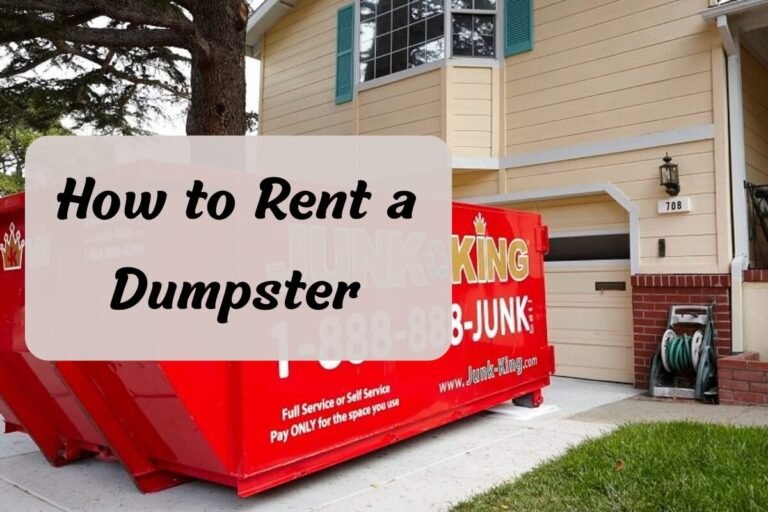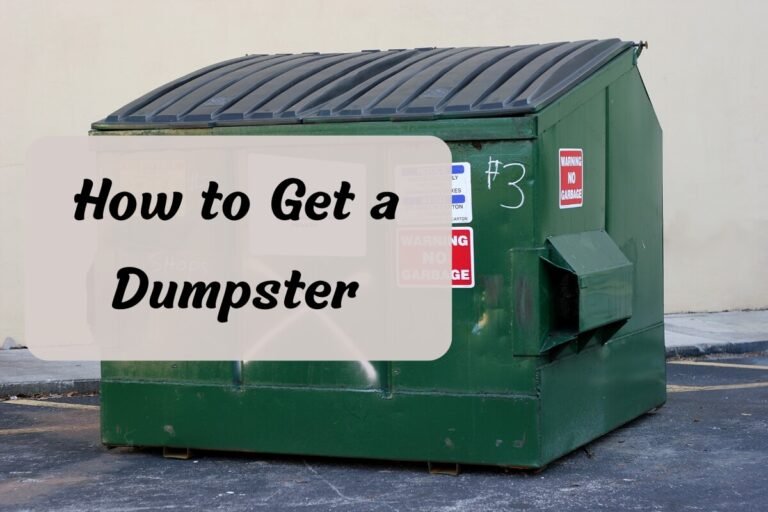What Size Dumpster Do I Need? A Comprehensive Guide

Determining the appropriate dumpster size for your task is vital to ensure efficient and economical waste disposal. This guide examines the key factors to consider when selecting a dumpster size, provides recommended sizes for different project types, and offers practical tips to assist you in making an informed choice.
Renting the wrong dumpster size can lead to overpaying or facing the hassle of needing multiple dumpsters, costing you time and money. On the other hand, selecting the appropriate size can streamline your waste disposal, maximize efficiency, and maintain a safe and organized workspace. So, let’s explore what size dumpster you need for your specific project.
Understanding Dumpster Sizes and Dimensions
Dumpsters come in several standard sizes, typically ranging from 10 to 40 cubic yards. Each size has specific dimensions and weight limits to accommodate different volumes and types of debris. Here’s a quick overview:
10 Yard Dumpster
- Dimensions: Approximately 14 feet long, 7.5 feet wide, and 3.5 feet tall
- Weight Limit: 1-3 tons (4,000 – 6,000 lbs)
15 Yard Dumpster
- Dimensions: Approximately 16 feet long, 7.5 feet wide, and 4.5 feet tall
- Weight Limit: 2-3 tons (4,000 – 6,000 lbs)
20 Yard Dumpster
- Dimensions: Approximately 22 feet long, 7.5 feet wide, and 4.5 feet tall
- Weight Limit: 2-3 tons (4,000 – 6,000 lbs)
30 Yard Dumpster
- Dimensions: Approximately 22 feet long, 7.5 feet wide, and 6 feet tall
- Weight Limit: 3.5-5 tons (7,000 – 10,000 lbs)
40 Yard Dumpster
- Dimensions: Approximately 22 feet long, 7.5 feet wide, and 8 feet tall
- Weight Limit: 5-6 tons (10,000 – 12,000 lbs)
To better visualize these sizes, a 10-yard dumpster can hold approximately four pickup truck loads of debris, while a 40-yard dumpster can accommodate around 12-16 pickup truck loads.
Factors to Consider When Choosing a Dumpster Size
Selecting the appropriate dumpster size involves considering several key factors to ensure a seamless and cost-effective waste disposal process. Here are the main considerations:
Type of Debris/Materials
The type of debris or materials you need to dispose of can significantly impact the required dumpster size. Heavy items like concrete, bricks, and roofing shingles may necessitate a smaller dumpster to avoid exceeding weight limits. Conversely, bulky but lightweight items like furniture or cardboard boxes might require a larger dumpster to accommodate their volume.
Project Scope and Volume of Waste
The scale of your project will dictate the overall volume of waste you need to manage. Larger projects, such as whole-home renovations or commercial construction, will likely require larger dumpsters like 30 or 40-yard options. Smaller projects, like a single-room remodel or garage cleanout, may be better suited for a 10 or 15-yard dumpster.
Property Size and Access
Consider the available space on your property and the accessibility of the dumpster location. Larger dumpsters may not fit comfortably in tight spaces or driveways, so you might need to opt for a smaller size or multiple smaller dumpsters. Additionally, ensure there are no overhead obstructions like power lines or low-hanging tree branches that could hinder dumpster delivery and pickup.
Budget and Rental Costs
While larger dumpsters typically have higher rental costs, the overall cost may be lower than renting multiple smaller dumpsters for a large project. Factor in your budget and weigh the trade-offs between dumpster size and potential additional fees for weight overages or multiple rentals.
Recommended Dumpster Sizes by Project Type
To help you make an informed decision, here are some general recommendations for dumpster sizes based on common project types:
Home Cleanouts and Decluttering
- Recommended Size: 15-20 yard dumpster
- Examples: Whole-home cleanouts, estate sales, hoarding situations
Bathroom/Kitchen Remodels
- Recommended Size: 10-20 yard dumpster
- Examples: Removing cabinets, countertops, flooring, fixtures
Roofing Projects
- Recommended Size: 10-20 yard dumpster
- Examples: Asphalt shingle removal, roof tear-offs
Landscaping and Yard Waste
- Recommended Size: 10-20 yard dumpster
- Examples: Tree/bush removal, soil, sod, landscaping debris
Construction and Demolition
- Recommended Size: 20-40 yard dumpster
- Examples: New home construction, additions, demolitions
Moving and Relocation
- Recommended Size: 20-30 yard dumpster
- Examples: Household moves, apartment/office relocations
Tips for Estimating Dumpster Size Needs
While the above recommendations provide a general guideline, it’s essential to estimate your specific needs accurately. Here are some tips to help you calculate the appropriate dumpster size:
Roofing Projects: For roofing projects, calculate the total “roofing squares” by dividing your roof’s square footage by 100. Generally, a 10-yard dumpster can handle up to 25 roofing squares, a 20-yard dumpster for 50 squares, and a 30-yard dumpster for over 50 squares.
Visualizing Volume: Imagine the volume of debris in terms of standard pickup truck loads. A 10-yard dumpster can hold approximately four truck loads, a 20-yard dumpster can handle eight truck loads, and so on.
Accounting for Weight: If you’re dealing with heavy materials like concrete or bricks, opt for a smaller dumpster size to avoid exceeding weight limits. A 10-yard dumpster might be more suitable for a small volume of heavy debris.
Allowing Extra Room: When in doubt, consider renting a slightly larger dumpster size to accommodate bulky or oddly-shaped items that may take up more space than anticipated.
Benefits of Renting the Right Size Dumpster
Choosing the correct dumpster size offers several advantages that can save you time, money, and hassle:
Cost-Effectiveness
Renting the appropriate size dumpster can help you avoid overpaying for a larger dumpster than needed or incurring additional fees for multiple smaller dumpsters.
Efficient Disposal
With the right dumpster size, you can streamline the disposal process, minimizing the need for frequent trips to the dump or transfer station.
Safety and Workspace Organization
A properly sized dumpster helps maintain a clean and organized workspace, reducing clutter and potential safety hazards on your project site.
Compliance with Local Regulations
Many municipalities have regulations regarding dumpster sizes, placement, and weight limits. Renting the right size can help you avoid potential fines or penalties for non-compliance.
Frequently Asked Questions about Dumpster Sizes
To further assist you in making an informed decision, here are some frequently asked questions and their answers:
What is the most popular/common dumpster size?
The 20-yard dumpster is one of the most commonly rented sizes, as it can accommodate a wide range of residential and light commercial projects.
How much does it cost to rent a dumpster?
Dumpster rental costs can vary based on location, size, rental duration, and additional fees. On average, expect to pay between $426 to $857 for a standard rental period, with larger dumpsters being more expensive.
What happens if I exceed the weight limit?
Most rental companies will charge an overage fee per ton if you exceed the dumpster’s weight limit. These fees can add up quickly, so it’s crucial to estimate your debris weight accurately.
Can I keep the dumpster on-site for an extended period?
Yes, many rental companies offer long-term or monthly rental options for projects that require an on-site dumpster for an extended duration.
What types of waste are prohibited in dumpsters?
Hazardous materials, such as chemicals, asbestos, and certain types of electronics, are typically not allowed in rental dumpsters. Most rental companies have strict guidelines on prohibited items to ensure proper disposal methods and comply with environmental regulations. Here are some common examples of materials that are generally not permitted in rental dumpsters:
- Hazardous chemicals (pesticides, paints, solvents, etc.)
- Asbestos-containing materials
- Batteries
- Tires
- Refrigerators or appliances containing refrigerants
- Electronics (TVs, computers, monitors)
- Fluorescent light bulbs
- Medical waste
- Explosives or ammunition
It’s essential to check with your specific rental company for a comprehensive list of prohibited items. Failure to comply with these guidelines may result in additional fees or even legal repercussions.
How long can I keep the dumpster on-site?
Most dumpster rental companies offer flexible rental periods to accommodate your project’s timeline. Standard rental periods can range from a few days to a week or more. However, if you require an on-site dumpster for an extended duration, many companies offer long-term or monthly rental options.
Long-term rentals are particularly useful for larger-scale projects, such as home renovations, commercial construction, or demolition, where waste disposal is an ongoing process. These rentals typically come with discounted rates compared to shorter rental periods.
Communicate your project timeline with the rental company upfront. They’ll provide the best rental period and arrange for periodic dumpster pickups or swaps if needed.
Keeping the dumpster on-site beyond the agreed rental period may incur extra fees or penalties, so plan ahead.
Conclusion
Choosing the right dumpster size is crucial for ensuring a smooth and efficient waste disposal process during your project. By considering factors such as the type of debris, project scope, property size, and budget, you can select the appropriate dumpster size that meets your needs without overpaying or facing logistical challenges.
Remember to estimate your dumpster size requirements accurately, taking into account the volume and weight of the materials you need to dispose of. Don’t hesitate to consult with rental companies or seek expert advice if you’re unsure about the best size for your specific project.
Renting the correct dumpster size not only saves you time and money but also helps maintain a safe and organized workspace while ensuring compliance with local regulations. By following the guidelines and recommendations outlined in this comprehensive guide, you can confidently tackle your next project with the peace of mind that comes from proper waste management planning.






